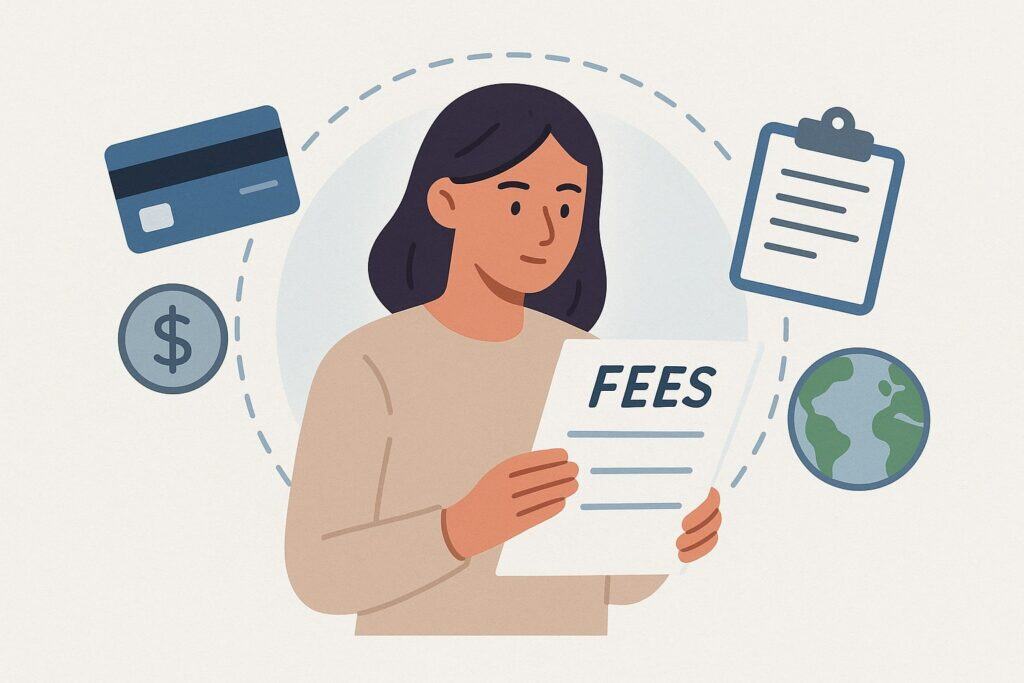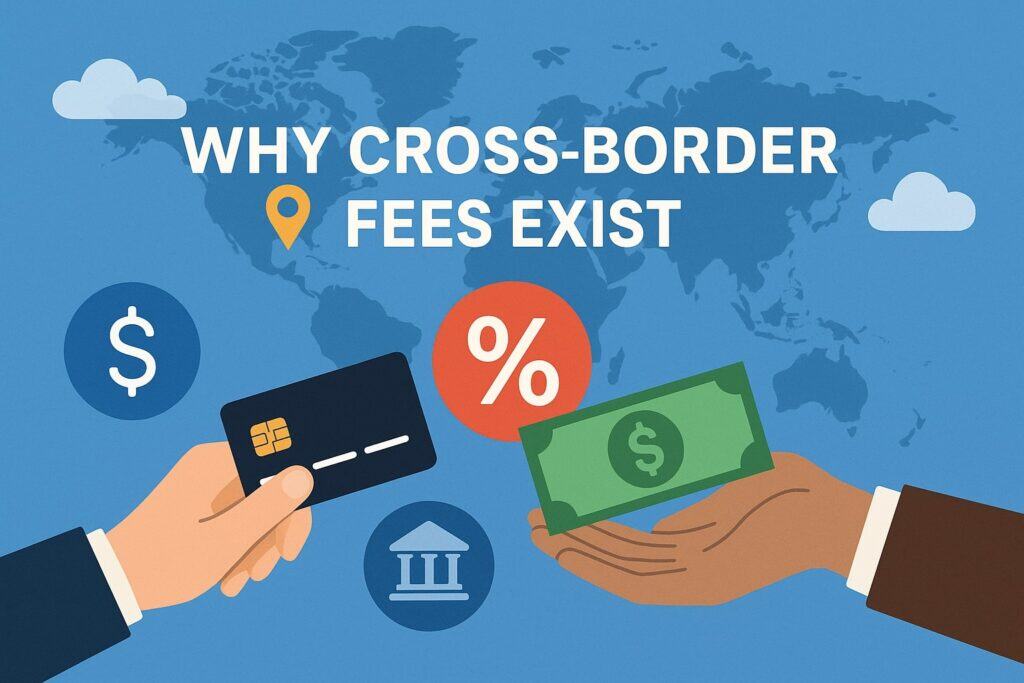
By crossborderfees October 11, 2025
Paying or getting paid across countries doesn’t have to be expensive. Yet many people and businesses still lose money to cross-border fees: foreign transaction fees, card network assessments, dynamic currency conversion (DCC) markups, intermediary bank charges, and surprise FX spreads.
This guide explains what those cross-border fees are, why they show up, and—most importantly—the proven ways you can avoid or minimize them without adding operational friction.
You’ll learn practical tactics for cards, bank transfers, and modern fintech rails. We’ll also spotlight special rules in the EU/EEA, the UK, and the U.S., along with step-by-step auditing tips so you stop overpaying cross-border fees for good.
Understand What Cross-Border Fees Actually Are (and Where They Hide)

Cross-border fees appear whenever a payment touches two different countries or currencies. On cards, you’ll typically see (1) a card-network assessment that’s specific to cross-border activity, (2) a foreign transaction fee from your bank/issuer, and (3) an FX conversion spread that’s baked into the final exchange rate.
A classic consumer example is buying online from a foreign website or tapping your card while traveling. Many card issuers explicitly list a “foreign transaction fee,” often between 1% and 3%, layered on top of any network processing costs and FX spread. Knowing where cross-border fees originate helps you pick the right rail and reduce total cost at the source.
On top of that, you may face dynamic currency conversion (DCC) at a checkout terminal or online gateway. DCC offers to charge you in “your home currency” while abroad, but the exchange rate is usually inflated, so you pay more.
It’s labeled as a convenience, yet it’s one of the most avoidable cross-border fees if you always choose to pay in the local currency. Media and card-travel experts consistently advise refusing DCC to dodge extra charges hidden in the conversion.
We’ll show you exactly how to avoid it later—just remember that DCC equals higher cross-border fees with almost no upside.
For bank transfers, cross-border fees can include wire initiation fees, correspondent/intermediary bank deductions, and nontransparent FX spreads.
In Europe, SEPA rules have dramatically lowered friction for euro transfers by requiring equal pricing for domestic and cross-border euro payments, but only when you actually send euros across the SEPA scheme.
If you accidentally trigger a non-SEPA transfer, you can still get hit by traditional wire charges and FX spreads—two common cross-border fees to watch for.
Why Cross-Border Fees Exist: The Mechanics Behind Cards, FX, and Networks

At a high level, cross-border fees compensate networks, issuers, acquirers, and banks for added risk, compliance, and processing when a payment crosses borders. On card rails, each network sets specific assessments for transactions where the merchant and cardholder are in different countries.
For example, Mastercard publishes an Acquirer Cross-Border Assessment that applies when the merchant’s and cardholder’s country codes differ. It’s currently 0.60% when the transaction currency is CAD and 1.00% when the currency is not CAD (per the Canadian schedule; other regions follow similar logic).
This is separate from the standard volume assessment and separate from the issuer’s foreign transaction fee you may see as a consumer. Understanding those moving parts lets you attack cross-border fees from multiple angles.
Visa, similarly, applies international assessments as part of its rules and fees framework, and issuers often add their own foreign transaction fee (commonly 1%–3% to consumers when applicable).
While specific international assessment percentages can vary by region and over time, the principle remains: a network cross-border assessment + issuer markup + FX spread is what most cardholders experience as cross-border fees.
Knowing that construction is key to choosing cards that advertise “no foreign transaction fees” and to pushing acquirers for local solutions that remove or reduce the network’s cross-border classification.
Regulation also shapes cross-border fees. In the EU, consumer card surcharging is banned for most regulated cards, which changes how merchants price but doesn’t erase the underlying network and FX costs.
Elsewhere, regulators are examining inter-regional card fee caps and cross-border pricing power. If you sell into Europe, process in Europe, or accept European tourists, these rules directly affect the cross-border fees you’ll pay or pass through.
We’ll break down the most relevant rules in the regional section so you can align your payment strategy and curb cross-border fees structurally.
The Sneakiest Cost: Dynamic Currency Conversion (DCC)

Dynamic currency conversion is a prime driver of unnecessary cross-border fees. At a terminal or checkout page, you may be asked whether you want to pay in your “home” currency (e.g., USD) instead of the local currency (e.g., EUR).
Choosing your home currency triggers a third-party conversion using a marked-up rate. You’ll see the total in your familiar currency, but you often pay materially more than you would if your bank/card issuer handled the conversion at a competitive network rate.
That extra amount is, effectively, pure cross-border fees you can avoid by declining DCC every time. Consumer finance resources and travel experts are unanimous on this point.
What makes DCC so insidious is that the offer can appear helpful. You’ll be shown the amount in your home currency and a friendly message about “locking in” the rate. But the spread used in DCC—often several percentage points—easily eclipses any issuer foreign transaction fee you might have otherwise paid with a no-FX-fee card.
If you’re a business, DCC can show up on B2B payments too, particularly with international card-on-file transactions or certain gateways. Training staff and configuring gateways to avoid DCC wherever possible is among the lowest-effort, highest-impact ways to cut cross-border fees from day one.
Core Consumer Strategies to Minimize Cross-Border Fees
Choose Cards With No Foreign Transaction Fees (and Use Them Correctly)
Your first line of defense against cross-border fees is a card that explicitly advertises no foreign transaction fees. Many major issuers now offer such cards, and some brands (like certain Capital One and Discover products in the U.S.) eliminate the issuer’s foreign transaction fee entirely.
That doesn’t mean all cross-border costs vanish—network assessments and FX spreads still exist in the background—but you’ll avoid that common 1%–3% issuer surcharge on everyday travel and online purchases.
Always verify in the card’s “Rates and Fees” table before you apply or swipe. Then, when you pay abroad, always choose the local currency to neutralize DCC and keep cross-border fees to a minimum.
To boost savings, enable travel notifications, use chip-and-PIN where common, and add your no-FX-fee card to mobile wallets for tokenized security. If you carry multiple cards, prioritize the one with no foreign transaction fees and strong travel protections.
Finally, know your issuer’s cash advance rules—ATM withdrawals on a credit card can trigger extra cross-border fees and interest.
If you need cash, a debit card from a bank that reimburses network ATM fees (and avoids its own foreign ATM markup) can reduce your total cross-border fees while you’re on the road. These simple habits make a measurable difference.
Kill DCC Everywhere: “Local Currency” Is Your Golden Rule
As a consumer, you have near-total control over DCC—just say no. At restaurants, retail shops, hotels, and e-commerce checkouts, be ready for the DCC prompt and ask for the charge in the local currency.
If staff insists or seems unsure, politely request “charge me in EUR/JPY/etc., not in USD.” When you see a printed slip, double-check the currency before you sign. Even with a no-FX-fee card, accepting DCC can silently re-insert cross-border fees that you otherwise avoided.
This “local currency” rule applies to online gateways as well: if a site offers to convert for you, decline it and let your bank do the math at the network rate. Over a long trip or a year of international buys, refusing DCC can save far more than juggling loyalty bonuses, because DCC markups are pure cross-border fees that add no value.
Business Playbook: Slash Cross-Border Fees in Your Payment Stack
Use Local Acquiring and Multi-Currency Pricing (MCP)
Merchants can materially reduce cross-border fees by processing locally in major buyer markets. When the acquirer, gateway, and settlement currency match the buyer’s region, many transactions stop qualifying as “cross-border” at the network level, lowering assessments and improving authorization rates.
Pair local acquiring with multi-currency pricing (MCP) so customers pay in their own currency without DCC. The acquirer settles to you in the target currency (or converts at wholesale), often at tighter spreads than ad-hoc DCC.
This structural shift trims cross-border fees per transaction while boosting conversion, especially in Europe, the UK, Canada, Australia, and key APAC hubs.
Also review card-brand rules around inter-regional interchange and network fees for tourists. In the EU, caps on certain inter-regional interchange for non-EU tourist cards have been extended to 2029, which can lower part of the cost base for in-store tourist spend.
Combined with local acquiring and MCP, this helps you build a global pricing strategy that systemically reduces cross-border fees rather than chasing one-off fixes.
Respect EU Surcharge Rules and Lean on SEPA for Euro Payments
If you sell to EU consumers, remember that PSD2 bans surcharging for most consumer debit and credit cards—domestic and cross-border. That means you can’t tack on extra card fees at checkout to offset cross-border fees.
Instead, use routing optimization, local acquiring, and alternative rails (like SEPA Credit Transfer/Direct Debit) where appropriate. SEPA rules also require that banks price cross-border euro transfers the same as domestic—a powerful lever for B2C refunds, vendor payouts, and payroll within the euro area.
By steering euro payments onto SEPA, you move value on an inexpensive, standardized rail and avoid many legacy wire cross-border fees entirely.
Bank Transfers and Account-to-Account: When to Use Them (and When Not To)
SEPA, ACH, FPS & Faster Rails: Keep Currency Native to Dodge FX
Account-to-account (A2A) payments can be a highly effective way to reduce cross-border fees if you keep currency native. Within the euro area, SEPA Credit Transfer and SEPA Instant move euros across borders at domestic-equivalent pricing, thanks to EU rules that equalize fees between domestic and cross-border euro payments.
In the UK, Faster Payments offers instant GBP moves domestically. In the U.S., ACH and FedNow provide low-cost domestic settlement in USD. The trick for global flows is to collect locally in the buyer’s currency (EUR via SEPA, GBP via FPS, USD via ACH) and then consolidate via treasury tools that convert in bulk at institutional spreads.
This avoids piecemeal FX on every transaction—one of the most common sources of cross-border fees for growing businesses.
However, beware of out-of-scheme transfers. If your bank defaults to SWIFT for what could have been a SEPA transfer, you may incur correspondent bank deductions and opaque FX spreads.
Ask your bank to force SEPA when IBANs are in the euro area and to route domestically whenever a local rail exists. This small operational control can reduce cross-border fees dramatically across vendor payments, payroll, and refunds.
Avoid “Retail” FX and Intermediary Deductions With Better Routing
When you must use SWIFT, reduce cross-border fees by controlling the route. Ask your bank to send charges as OUR (you pay all bank fees) for vendor-critical payouts so beneficiaries receive the full amount; for refunds, SHA may be fine.
Confirm whether your bank has in-country correspondent relationships that avoid extra hops. Finally, compare your bank’s FX spread against treasury providers or fintech platforms; even a 50–100 bps improvement on the rate can eclipse fixed wire fees and cut overall cross-border fees more than any other single action.
Region-Specific Rules That Change Your Cost Structure
European Union / EEA: Equalized Euro Pricing, No Consumer Surcharges
For euro payments, Regulation (EC) No 924/2009 requires banks to apply the same charges for domestic and cross-border electronic payments in euro, which is why SEPA is a cornerstone of low-cost European flows.
The rule has been paired with the SEPA Regulation (EU) 260/2012, which mandated the technical/business requirements and migration to SEPA instruments. On cards, PSD2 bans surcharging consumers for most regulated debit/credit cards, whether domestic or cross-border.
Merchants must build pricing that absorbs card costs, which places a premium on local acquiring, strong routing, and MCP to limit cross-border fees at the network level.
There’s also an EU settlement extending caps on inter-regional interchange for non-EU tourist cards through 2029, keeping those elements predictable.
If you operate in travel retail, hospitality, or attractions, these caps may support lower acceptance costs on tourist spend—again, only part of the stack but relevant to total cross-border fees.
United Kingdom: Scrutiny of Cross-Border Card Fees Post-Brexit
Post-Brexit, card schemes raised certain cross-border fees on UK–EU ecommerce, prompting the UK Payment Systems Regulator to consult on capping them. The PSR has flagged that lack of competition allowed fees to rise, imposing significant costs on UK businesses selling to European customers.
Depending on final outcomes, UK merchants could see relief on some cross-border card costs. Until then, local acquiring in the EU, plus MCP and A/B routing, remain your best tools to shrink cross-border fees for EU-bound buyers.
Advanced Tactics for Companies With Meaningful FX Exposure
Centralize Treasury, Net Flows, and Hedge FX to Lower Implicit Fees
If you have recurring multi-currency inflows/outflows, the most expensive cross-border fees are often implicit inside frequent FX conversions.
The fix is a treasury program that (1) collects locally and keeps funds in native currency, (2) nets payables and receivables per currency, and (3) converts in bulk through competitive liquidity providers.
Adding forwards or NDFs can stabilize your budget rates so you avoid overpaying during volatility—effectively capping part of your cross-border fees that would otherwise appear as wider FX spreads during peak periods.
Combine this with tiered settlement cycles (e.g., weekly EUR→USD conversion) and you’ll meaningfully compress your all-in global payment cost.
Data-Driven Routing: Domestic First, Inter-Regional Only When Needed
Instrument your checkout and payout flows to route by BIN country, IP/Geo, and currency. Prioritize domestic rails (SEPA, ACH, FPS) or in-region acquiring to avoid escalating cross-border fees.
On cards, maintain multiple acquirers with smart failover; use MCC-aware rules; and enable multi-currency pricing on high-volume currencies. For B2B, ask large suppliers to accept local currency via domestic rails to eliminate FX.
With the right playbook, you can reduce both explicit fees and decline-driven losses—another hidden form of cross-border fees—by aligning each transaction with its least-cost, highest-approval path.
How to Audit Your Current Costs and Find Quick Wins
Step-by-Step Audit for Consumers and Freelancers
Pull three months of statements and mark every foreign transaction. Note the currency, country, and whether DCC was used. Then, check each card’s fee schedule for foreign transaction fees. If you see 3% regularly, switch to a no-foreign-transaction-fee card and train yourself to always pick local currency at checkout.
Where you pay vendors abroad, compare your bank’s outbound transfer rates with fintech alternatives—especially for common corridors—to see if you can trim cross-border fees by improving the exchange rate. This simple exercise often cuts total cost by 30–70 bps with zero lifestyle change.
Step-by-Step Audit for SMBs and Enterprises
Export payment data with fields for issuer/brand, BIN country, merchant/acquirer country, currency, approval code, network fees, acquirer fees, FX rate applied, and chargeback reason.
Identify where transactions are classified as cross-border by networks and where DCC is slipping through. Quantify your effective FX spread by comparing realized conversion rates to mid-market benchmarks. Next, model savings from local acquiring in your top two buyer regions and from SEPA/FPS/ACH routing for payouts.
Run an A/B for two settlement cycles and compare acceptance, fees, and net revenue. These audits nearly always reveal structural cross-border fees you can eliminate without harming CX.
Frequently Asked Questions (FAQ)
Q1) What are the easiest ways to avoid cross-border fees on a vacation?
Answer: Bring at least one no-foreign-transaction-fee credit card and always choose the local currency at checkout to avoid DCC. Use ATMs from major banks for cash, and consider a debit card that reimburses ATM network fees.
For lodging and tours you book online, check if the merchant can bill in local currency so your bank handles FX at a competitive rate. These simple habits cut most consumer cross-border fees without reducing convenience.
Q2) Are dynamic currency conversion charges legal?
Answer: Yes, but they’re typically optional. DCC is marketed as a convenience, but experts recommend declining it because the exchange rate is usually worse than your bank’s rate—resulting in higher cross-border fees. You can usually avoid it by requesting charges in the local currency.
Q3) How do European rules help me reduce cross-border fees?
Answer: For euro payments, EU law requires equal pricing for domestic and cross-border electronic payments in euro. That’s why SEPA transfers are so cheap across borders.
Also, PSD2 bans surcharges on most consumer card payments, which affects checkout pricing and steers businesses toward structural cost fixes (local acquiring, MCP) rather than add-on fees. These policies, used correctly, significantly shrink cross-border fees across European flows.
Q4) I’m a UK merchant selling to EU customers. What can I do today?
Answer: Until new caps are finalized, reduce cross-border fees by standing up EU local acquiring, enabling multi-currency pricing, and optimizing routing.
Keep an eye on the PSR’s process, which is examining cross-border card fees on UK–EU ecommerce and may cap them. Structural moves now will lift approval rates and lower costs regardless of the regulatory outcome.
Q5) Are “no-FX-fee” cards truly free of cross-border fees?
Answer: They generally waive the issuer’s foreign transaction fee, which is a big win. But other elements—like network cross-border assessments and FX spread—still exist in the background.
You’ll still save meaningfully versus cards that charge 1%–3%, especially if you also avoid DCC. That’s how you get your effective cross-border fees as low as possible.
Q6) What about inter-regional tourist card fees in the EU?
Answer: Inter-regional interchange caps for non-EU tourist cards have been extended to 2029, keeping those elements stable. This can reduce part of the acceptance cost on tourist spend, but you should still prioritize local acquiring/MCP to further cut cross-border fees.
Conclusion
You can’t eliminate every single international charge, but with the right setup, cross-border fees become small and predictable—often negligible. For consumers, the winning formula is simple: no-foreign-transaction-fee cards, local currency at checkout, and smart ATM use.
For businesses, pursue local acquiring, multi-currency pricing, and domestic rails (SEPA, ACH, FPS) wherever possible. Supplement with treasury best practices—net flows, bulk FX, and hedging—to slash implicit FX costs that masquerade as cross-border fees.
Finally, get serious about audits: find where DCC sneaks in, where SWIFT routes add intermediaries, and where you’re converting currency too often. Put those insights into routing rules, acquirer strategy, and vendor instructions.
Do this, and you’ll keep more of every cross-border dollar, euro, pound, or yen—proving that cross-border fees are not a “cost of doing business,” but a variable you can manage, minimize, and in many cases, avoid.